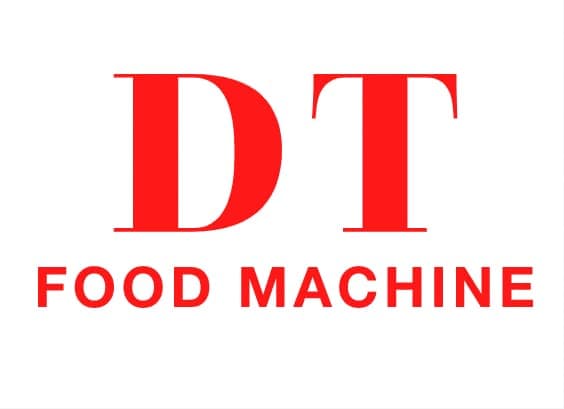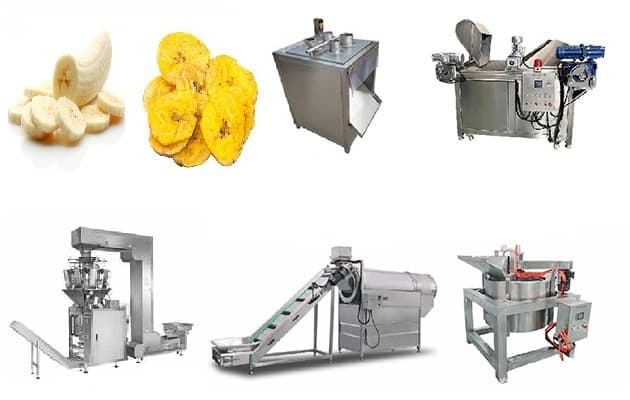Los chips de plátano se encuentran entre las opciones de bocadillos saludables más populares en todo el mundo. Crujiente, sabroso, Y con larga vida útil, se consumen en Asia, África, y América Latina, y su demanda está creciendo en Europa y América del Norte. Si usted es un empresario o inversor que planea ingresar a la industria de la fabricación de alimentos, Una fábrica de chips de plátano es un emprendimiento rentable y escalable.. En esta guía, Le explicaremos todo lo que necesita saber para iniciar un negocio de producción de chips de plátano, desde la selección de maquinaria hasta la estimación de los costos de instalación..
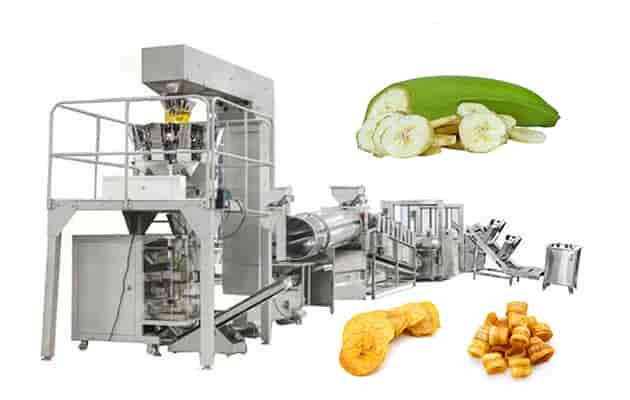
1. Potencial de mercado para los chips de plátano
El mercado mundial de chips de plátano Se prevé que crezca a una CAGR de más de 6% en los próximos años. La creciente demanda de productos saludables, bocadillos a base de plantas, junto con una creciente urbanización y poblaciones de clase trabajadora, contribuye significativamente a esta tendencia. Además, Los chips de plátano tienen un enorme potencial de exportación debido a su vida útil más larga y a la demanda en los mercados de snacks veganos y sin gluten..
Tendencias clave del mercado:
- Aumento de las tendencias de snacks saludables
- La creciente demanda de alimentos envasados
- Crecimiento del comercio electrónico y de las marcas directas al consumidor
2. Tipos de chips de plátano
Antes de iniciar su fábrica, Decide qué tipo de chips de plátano planeas producir.:
2.1 Chips de plátano frito
- Frito en aceite vegetal
- Popular en el sudeste asiático, África, y la india
- Variantes: salado, picante, dulce
2.2 Chips de plátano al horno
- Más saludable, menor contenido de aceite
- Preferido en los países occidentales.
2.3 Chips de plátano liofilizados
- categoría premium
- Ligero, Larga vida útil
Su elección afectará a la maquinaria., diseño de línea de producción, y mercados objetivo.
3. Proceso de producción de chips de plátano paso a paso
- Selección de plátano crudo
- Sabá, Nendran, o se prefieren plátanos.
- Peladura
- Peladoras de plátanos manuales o mecánicas.
- Cortes
- El corte uniforme garantiza una fritura uniforme y una textura consistente.
- Lavado
- Elimina almidón e impurezas..
- Blanqueo (Opcional)
- Mejora la nitidez y el color..
- Freír/hornear
- Freidoras u hornos de aire caliente, dependiendo del tipo de chip.
- Degradado (para patatas fritas)
- Las máquinas desengrasantes ayudan a reducir el contenido de aceite.
- Condimento
- Sabores como el queso, chile picante, o miel.
- Enfriamiento
- Sistemas de enfriamiento tipo transportador.
- Embalaje
- Máquinas empacadoras automáticas de bolsas con lavado de nitrógeno para mantener la frescura.
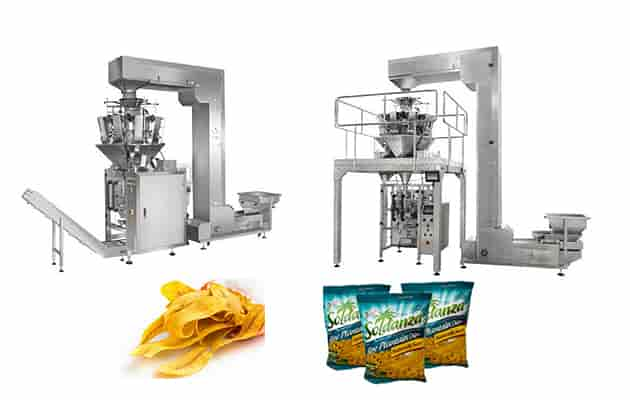
4. Línea de producción de chips de plátano & Maquinaria requerida
A continuación se muestra una lista de las máquinas esenciales que necesitará para construir una planta procesadora de chips de plátano completamente automática.:
4.1 Máquina de pelar
- Capacidad: 300–1000 kg/h
- Cuerpo de acero inoxidable
4.2 Máquina cortadora de plátano
- Espesor ajustable
- Tipo de cuchilla rotativa o centrífuga
4.3 Lavadora
- Lavadora de burbujas o tipo tambor giratorio
4.4 freidora
- Freidora: Adecuado para configuraciones de pequeña escala
- Freidora Continua: Lo mejor para escala industrial
- Sistemas de filtración de aceite y control de temperatura incluidos.
4.5 Máquina de engranaje
- Sistema centrífugo para reducir el exceso de aceite.
4.6 Máquina de condimentos
- Mezclador de tambor para un recubrimiento uniforme
4.7 Máquina de envases
- Pescador de múltiples cabezas + sello de llenado de formulario vertical (VFFS) máquina
- Sistema de lavado de nitrógeno para frescura.
Equipo opcional:
- Blanches
- Detector de metales
- Impresora de fecha
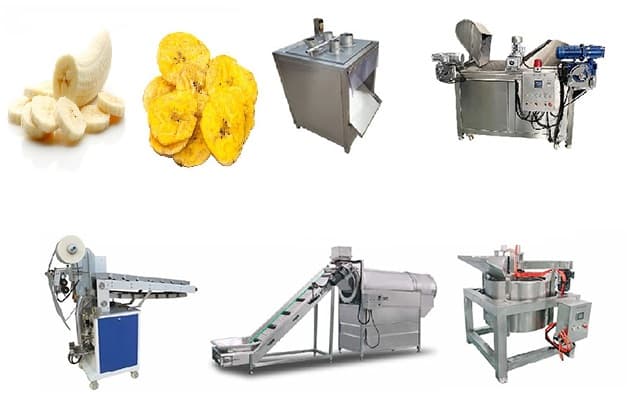
5. Diseño de maquetación para fábrica de chips de plátano
Diseño de planta a pequeña escala (500 kg/día)
- Requisito de espacio: 100–200 m²
- Línea semiautomática
Diseño de planta de mediana escala (1000–3000 kg/día)
- Requisito de espacio: 500–800 m²
- Totalmente automática con freidora continua.
Diseño industrial a gran escala (5000+ kg/día)
- Requisito de espacio: 1000+ m2
- Proyecto llave en mano con total automatización, sistema de reciclaje de aceite, gestión de residuos, etc..
6. Inversión & Desglose de costos
| Artículo | Costo estimado (Dólar estadounidense) |
|---|---|
| Máquinas de chips de plátano (linea completa) | $30,000 - $120,000 |
| Configuración de fábrica (edificio, utilidades) | $20,000 - $80,000 |
| Mano de obra y personal (primero 6 meses) | $10,000 - $25,000 |
| Materia prima & Embalaje | $5,000 - $15,000 |
| Certificaciones & Licencias | $2,000 - $5,000 |
| Marketing & Herrada | $3,000 - $10,000 |
| Inversión Total Estimada | $70,000 - $250,000 |
Los costos varían según la capacidad de producción., ubicación, y nivel de automatización.
7. Licencias & Requisitos reglamentarios
Licencias generales requeridas:
- Registro de empresas
- Licencia de seguridad alimentaria (P.EJ., FDA, Fsai)
- Licencia de exportación (si vende internacionalmente)
- Autorización ambiental
Asegúrese de cumplir con las normas locales e internacionales de seguridad alimentaria, como HACCP., ISO 22000, etc..
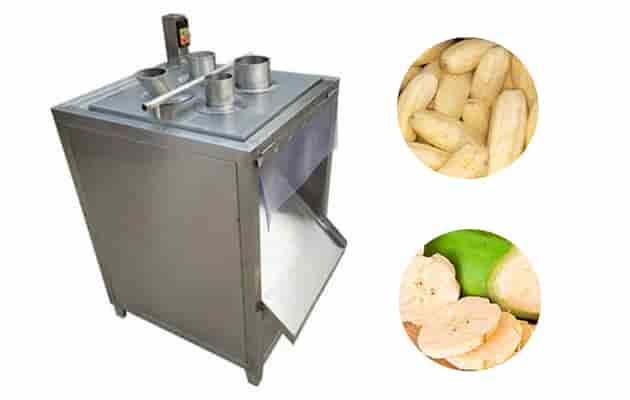
8. Marketing & Estrategia de distribución
Para escalar su negocio de chips de plátano, planificar ambos B2B y B2C canales:
B2B (Ventas al por mayor)
- Supermercados & cadenas minoristas
- Distribuidores & mayoristas
- Exportar a países extranjeros.
B2C (Ventas minoristas de paquetes)
- Plataformas de comercio electrónico (Amazonas, tienda)
- Sitio web de tu marca
- Anuncios en redes sociales
Consejos:
- Utilice envases atractivos con frentes transparentes
- Destacar «merienda saludable», «sin gluten», o «vegano» etiqueta
9. Margen de beneficio & ROI
Los chips de plátano ofrecen altos márgenes de beneficio de 30% a 50% dependiendo de la eficiencia, control de residuos, y marca. La mayoría de las fábricas pequeñas y medianas logran un retorno de la inversión en 12–24 meses.
10. Consejos para el éxito
- Invierta en máquinas de acero inoxidable de alta calidad
- Optimice el uso y la recuperación del petróleo.
- Innovar con nuevos sabores y envases
- Obtenga comentarios de los clientes con antelación para perfeccionar el producto
- Centrarse en la marca para destacar en un mercado de snacks abarrotado

Conclusión
Iniciar una fábrica de chips de plátano es una oportunidad de negocio prometedora con una fuerte demanda y potencial de exportación.. Eligiendo la maquinaria adecuada, configurar un diseño inteligente, e implementar un marketing eficaz, usted puede construir una empresa rentable de fabricación de snacks. Ya sea que esté comenzando con algo pequeño o planeando una instalación industrial grande, La clave del éxito reside en la consistencia del producto., control de calidad, y marca.
Necesita ayuda con la maquinaria para chips de plátano?
Somos un fabricante líder de máquinas de chips de plátano y líneas de producción llave en mano.. Contáctenos hoy para obtener una cotización personalizada y un diseño de planta adaptado a sus necesidades!
